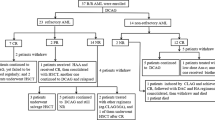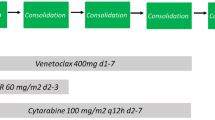Abstract
Background and Objectives
The therapy in elderly patients with acute myeloid leukemia (AML) is a big challenge because of poor risk factors and inferior tolerance to intensive chemotherapy. This study aims to compare the efficacy between reduced-intensity idarubicin plus cytarabine and daunorubicin plus cytarabine (IA regimen and DA regimen, respectively) in elderly patients with newly diagnosed AML.
Methods
We retrospectively investigated 74 patients with newly diagnosed non-M3 AML aged >60 years, where 33 patients received IA regimen, 30 patients received DA regimen, while 11 patients received supportive treatment. We observed the complete remission (CR) rates, overall survival (OS) and side effects in different arms.
Results
The CR rate in IA arm (70.4 %, 19/27) was significantly higher than that in DA arm (40 %, 10/25) in de novo AML (p = 0.028), and further significantly higher when white blood cell (WBC) count >10 × 109/L (p = 0.042) and ECOG (Eastern Cooperative Oncology Group) score <2 (p = 0.021). The overall survival of the entire population was poor with a median survival of 10 months, 1- and 2-year survival rates were 40.5 % (30/74) and 9.5 % (7/74). The median survival of the patients with chemotherapy was 12 months, which was significantly longer than patients treated supportively (4 months) (p < 0.001). There were no differences of median survival and duration of CR between two arms. Early mortality decreased in the past 5 years in both groups. Meanwhile, low-dose idarubicin was well tolerated in elderly patients.
Conclusions
Reduced-intensity chemotherapy offered an improvement in survival, and the reduced-intensity IA regimen could improve CR rate in elderly patients with de novo AML.




Similar content being viewed by others
References
Harousseau JL. Acute myeloid leukemia in the elderly. Blood. 1998;12:145.
Wheatley K, Brookes CL, Howman AJ, Goldstone AH, Milligan DW, Prentice AG, et al. Prognostic factor analysis of the survival of elderly patients with AML in the MRC AML11 and LRF AML14 trials. Br J Haematol. 2009;145:598–605.
Kantarjian H, O’Brien S, Cortes J, Giles F, Faderl S, Jabbour E, et al. Results of reduced intensive chemotherapy in 998 patients age 65 years or elder with acute myeloid leukemia or high-risk myelodysplastic syndrome: predictive prognostic models for outcome. Cancer. 2006;106(5):1090–8.
Appelbaum FR, Gundacker H, Head DR, Slovak ML, Willman CL, Godwin JE, et al. Age and acute myeloid leukemia. Blood. 2006;107(9):3481–5.
Juliusson G, Antunovic P, Derolf A, Lehmann S, Möllgård L, Stockelberg D, et al. Age and acute myeloid leukemia: real world data on decision to treat and outcomes from the Swedish Acute Leukemia Registry. Blood. 2009;113(18):4179–87.
Fröhling S, Schlenk RF, Kayser S, Morhardt M, Benner A, Döhner K, et al. Cytogenetics and age are major determinants of outcome in intensively treated acute myeloid leukemia patients elder than 60 years: results from AMLSG trial AML HD98-B. Blood. 2006;108(10):3280–8.
Farag SS, Archer KJ, Mrózek K, Ruppert AS, Carroll AJ, Vardiman JW, et al. Pretreatment cytogenetics add to other prognostic factors predicting complete remission and long-term outcome in patients 60 years of age or elder with acute myeloid leukemia: results from Cancer and Leukemia Arm B 8461. Blood. 2006;108(1):63–73.
Mosna F, Papayannidis C, Martinelli G, Di Bona E, Bonalumi A, Tecchio C, et al. Complex karyotype, elder age, and reduced first-line dose intensity determine poor survival in core binding factor acute myeloid leukemia patients with long-term follow-up. Am J Hematol. 2015;90(6):515–23.
Löwenberg B, Zittoun R, Kerkhofs H, Jehn U, Abels J, Debusscher L, et al. On the value of intensive remission-induction chemotherapy in elderly patients of 65+ years with acute myeloid leukemia: a randomized phase III study of the European Organization for Research and Treatment of Cancer Leukemia Group. J Clin Oncol. 1989;7(9):1268–74.
Spataro Vito, Kovacsovics Tibor. Acute myeloid leukemia in the elderly: results of an individualized approach in two centres. Leuk Lymphoma. 2000;39(5–6):521–30.
Medeiros BC, Satram-Hoang S, Hurst D, Hoang KQ, Momin F, Reyes C. Big data analysis of treatment patterns and outcomes among elderly acute myeloid leukemia patients in the United States. Ann Hematol. 2015;94:1127–38.
Kadia TM, Faderl S, Ravandi F, Jabbour E, Garcia-Manero G, Borthakur G, et al. Final results of a phase 2 trial of clofarabine and low-dose cytarabine alternating with decitabine in elder patients with newly diagnosed acute myeloid leukemia. Cancer. 2015;121(14):2375–82.
Büchner T, Hiddemann W, Berdel W, Wörmann B, Schoch C, Löffler H, et al. Acute myeloid leukemia: treatment over 60. Rev Clin Exp Hematol. 2002;6(1):46–59.
Vives S, Oriol A, Piernas S, Brunet S, Clapés V, Guardia R, et al. Feasibility and efficacy of outpatient therapy with intermediate dose cytarabine, fludarabine and idarubicin for patients with acute myeloid leukaemia aged 70 or elder. Eur J Haematol. 2015;95(6):576–82.
Kim H, Lee JH, Joo YD, Bae SH, Lee JH, Kim DY, et al. A prospective, multicenter phase II study of continuous infusion of FLAG for patients elder than 60 yr with resistant acute myeloid leukemia: a comparison with intensive younger patients’ trial. Eur J Haematol. 2016;96(2):188–97.
Jin J, Chen J, Suo S, Qian W, Meng H, Mai W, et al. Low-dose cytarabine, aclarubicin and granulocyte colony-stimulating factor priming regimen versus idarubicinplus cytarabine regimen as induction therapy for elder patients with acute myeloid leukemia. Leuk Lymphoma. 2015;56(6):1691–7.
Juliusson G; Swedish AML Arm. Most 70- to 79-year-old patients with acute myeloid leukemia do benefit from intensive treatment. Blood. 2011;117(12):3473–4.
Bennett JM, Catovsky D, Daniel MT, Flandrin G, Galton DA, Gralnick HR, et al. Proposed revised criteria for the classification of acute myeloid leukemia. A report of the French–American–British Cooperative Group. Ann Intern Med. 1985;103:460.
National Comprehensive Cancer Network. Acute Myeloid Leukemia (Version 2.2016). https://www.nccn.org/professionals/physician_gls/pdf/aml.pdf. Accessed 29 Aug 2016.
Creutzig U, Kaspers GJ. Revised recommendations of the International Working Group for diagnosis, standardization of response criteria, treatment outcomes, and reporting standards for therapeutic trials in acute myeloid leukemia. J Clin Oncol. 2004;22(16):3432–3.
Preisler HD. Failure of remission induction in acute myelocytic leukemia. Med Pediatr Oncol. 1978;4:275.
Lang K, Earle CC, Foster T, Dixon D, Van Gool R, Menzin J. Trends in the treatment of acute myeloid leukaemia in the elderly. Drugs Aging. 2005;22(11):943–55.
Oriol A, Ribera JM, Esteve J, Guàrdia R, Brunet S, Bueno J, et al. Feasibility and results of autologous stem cell transplantation in de novo acute myeloid leukemia in patients over 60 years old. Results of the CETLAM AML-99 protocol. Haematologica. 2004;89(7):791–800.
Oran B, Weisdorf DJ. Survival for elder patients with acute myeloid leukemia: a population-based study. Haematologica. 2012;97(12):1916–24.
Thomas XG, Arthur C, Delaunay J, Jones M, Berrak E, Kantarjian HM. A post hoc sensitivity analysis of survival probabilities in a multinational phase III trial of decitabine in older patients with newly diagnosed acute myeloid leukemia. Clin Lymphoma Myeloma Leuk. 2014;14(1):68–72.
Stuart RK, Cripe LD, Maris MB, Cooper MA, Stone RM, Dakhil SR, et al. REVEAL-1, a phase 2 dose regimen optimization study of vosaroxin in elder poor-risk patients with previously untreated acute myeloid leukaemia. Br J Haematol. 2015;168:796–805.
Dennis M, Russell N, Hills RK, Hemmaway C, Panoskaltsis N, McMullin MF, et al. Vosaroxin and vosaroxin plus low-dose Ara-c(LDAC) vs low-dose Ara-C alone in elder patients with acute myeloid leukemia. Blood. 2015;125(19):2923–32.
Howard DS, Liesveld J, Phillips GL 2nd, Hayslip J, Weiss H, Jordan CT, et al. A phase I study using bortezomib with weekly idarubicin for treatment of elderly patients with acute myeloid leukemia. Leuk Res. 2013;37(11):1502–8.
Pigneux A, Perreau V, Jourdan E, Vey N, Dastugue N, Huguet F, et al. Adding lomustine to idarubicin and cytarabine for induction chemotherapy in older patients with acute myeloid leukemia: the BGMT 95 trial results. Haematologica. 2007;92(10):1327–34.
De Witte T, Suciu S, Meert L, Halkes C, Selleslag D, Bron D, et al. Darubicin and cytarabine in combination with gemtuzumab ozogamicin (IAGO) for untreated patients with high-risk MDS or AML evolved from MDS: a phase II study from the EORTC and GIMEMA Leukemia Groups (protocol 06013). Ann Hematol. 2015;94(12):1981–9.
Li X, Xu S, Tan Y, Chen J. The effects of idarubicin versus other anthracyclines for induction therapy of patients with newly diagnosed leukaemia. Cochrane Database Syst Rev. 2015;. doi:10.1002/14651858.CD010432.pub2.
Gardin C, Chevret S, Pautas C, Turlure P, Raffoux E, Thomas X, et al. Superior long-term outcome with idarubicin compared with high-dose daunorubicin in patients with acute myeloid leukemia age 50 years and older. J Clin Oncol. 2013;31(3):321–7.
Thein MS, Ershler WB, Jemal A, Yates JW, Baer MR. Outcome of elder patients with acute myeloid leukemia: an analysis of SEER data over 3 decades. Cancer. 2013;119(15):2720–7.
Lübbert M, Suciu S, Hagemeijer A, Rüter B, Platzbecker U, Giagounidis A, et al. Decitabine improves progression-free survival in older high-risk MDS patients with multiple autosomal monosomies: results of a subgroup analysis of the randomized phase III study 06011 of the EORTC Leukemia Cooperative Group and German MDS Study Group. Ann Hematol. 2016;95(2):191–9.
Kantarjian HM, Thomas XG, Dmoszynska A, Wierzbowska A, Mazur G, Mayer J, et al. Multicenter, randomized, open-label, phase III trial of decitabine versus patient choice, with physician advice, of either supportive care or low-dose cytarabine for the treatment of older patients with newly diagnosed acute myeloid leukemia. J Clin Oncol. 2012;30(21):2670–7.
Ye XN, Zhou XP, Wei JY, Xu GX, Li Y, Mao LP, et al. Epigenetic priming with decitabine followed by low-dose idarubicin/cytarabine has an increased anti-leukemic effect compared to traditional chemotherapy in high-risk myeloid neoplasms. Leuk Lymphoma. 2015;13:1–8.
Li J, Chen Y, Zhu Y, Zhou J, Xu Y, Li Y, et al. Efficacy and safety of decitabine in combination with G-CSF, low-dose cytarabine and aclarubicin in newly diagnosed elderly patients with acute myeloid leukemia. Oncotarget. 2015;6(8):6448–58.
Extermann M, Boler I, Reich RR, Lyman GH, Brown RH, DeFelice J, et al. Predicting the risk of chemotherapy toxicity in elder patients: the Chemotherapy Risk Assessment Scale for High-Age Patients (CRASH) score. Cancer. 2012;118(13):3377–86.
Hurria A, Togawa K, Mohile SG, Owusu C, Klepin HD, Gross CP, et al. Predicting chemotherapy toxicity in elder adults with cancer: a prospective multicenter study. J Clin Oncol. 2011;29(25):3457–65.
Extermann M, Hurria A. Comprehensive geriatric assessment for elder patients with cancer. J Clin Oncol. 2007;25(14):1824–31.
Klepin HD, Geiger AM, Tooze JA, Kritchevsky SB, Williamson JD, Ellis LR, et al. The feasibility of inpatient geriatric assessment for elder adults receiving induction chemotherapy for acute myelogenous leukemia. J Am Geriatr Soc. 2011;59(10):1837–46.
Klepin HD, Geiger AM, Tooze JA, Kritchevsky SB, Williamson JD, Pardee TS, et al. Geriatric assessment predicts survival for elder adults receiving induction chemotherapy for acute myelogenous leukemia. Blood. 2013;121(21):4287–94.
Authors’ contributions
Zonghong Shao designed the research plan and revised the manuscript. Hui Liu analyzed the data and wrote the article. Rong Fu, Lijuan Li, Guojin Wang, Jia Song, Erbao Ruan, Huaquan Wang, Yuhong Wu, and Xiaoming Wang contributed to collection of cases. Kai Ding collected the information of the patients and revised the manuscript. All authors read and approved the final manuscript.
Author information
Authors and Affiliations
Corresponding author
Ethics declarations
Funding
This work was supported by the National Natural Science Foundation of China (Grant Nos. 81570106, 81570111, 81400088, 81400085), the anticancer major special project of Tianjin (Grant Nos. 12ZCDZSY18000, 12ZCDZSY17900), the Tianjin Municipal Natural Science Foundation (Grant Nos. 14JCYBJC25400, 15JCYBJC24300), the Science and Technology Foundation of Tianjin Municipal Health Bureau (Grant No. 2011kz115) and Tianjin Health and Family Planning Commision (Grant No. 15KG150).
Conflicts of interest
Hui Liu, Rong Fu, Lijuan Li, Guojin Wang, Jia Song, Erbao Ruan, Huaquan Wang, Yuhong Wu, Xiaoming Wang, Kai Ding, Zonghong Shao report no conflicts of interest.
Ethical approval
This study was in accordance with the 1964 Helsinki declaration and was approved by the Ethical Committee of the Tianjin Medical University.
Informed consent
Informed written consent was obtained from all patients or their parents in accordance with the Declaration of Helsinki.
Rights and permissions
About this article
Cite this article
Liu, H., Fu, R., Li, L. et al. Comparison of Reduced-Intensity Idarubicin and Daunorubicin Plus Cytarabine as Induction Chemotherapy for Elderly Patients with Newly Diagnosed Acute Myeloid Leukemia. Clin Drug Investig 37, 167–174 (2017). https://doi.org/10.1007/s40261-016-0469-9
Published:
Issue Date:
DOI: https://doi.org/10.1007/s40261-016-0469-9




